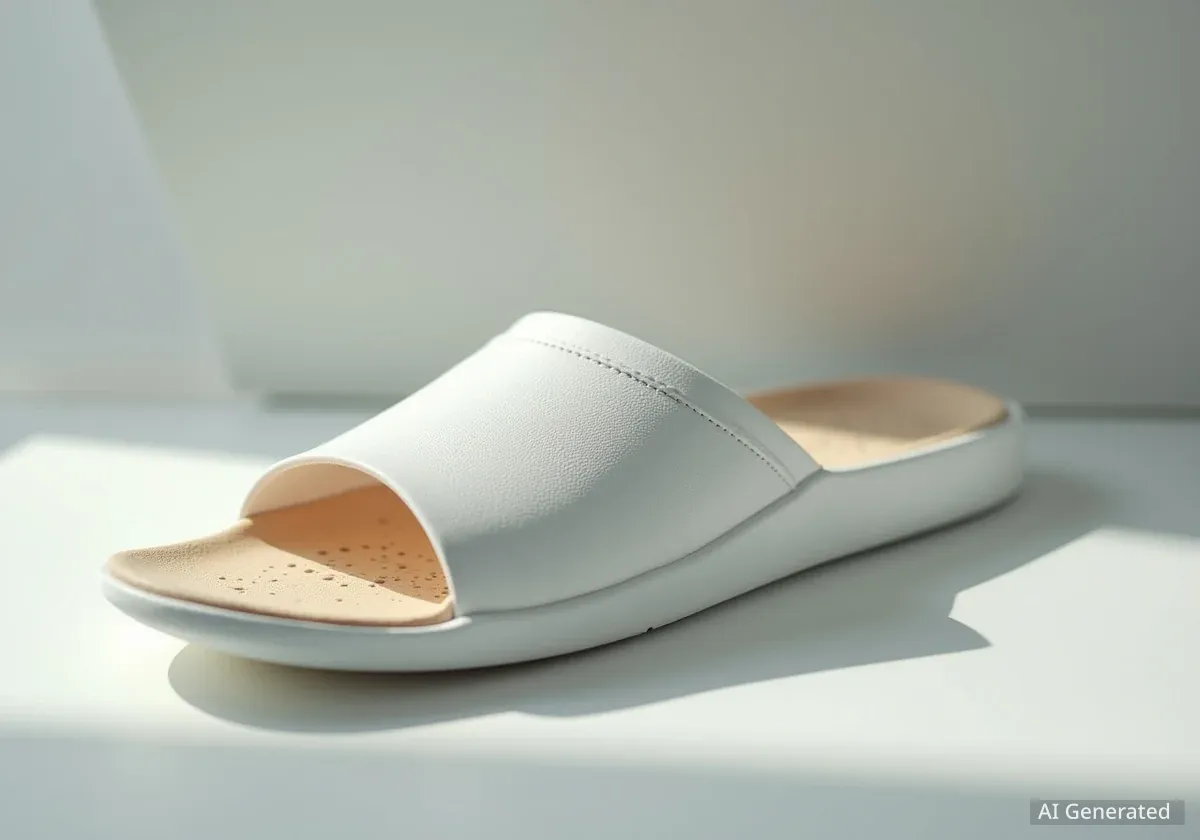The simple slide sandal, once a basic accessory for pools and locker rooms, has evolved into a piece of engineered footwear. Modern designs now incorporate advanced materials and ergonomic principles to enhance comfort, safety, and durability for a wide range of activities. This shift reflects a growing consumer demand for versatile products that blend casual style with technical performance.
At the core of this evolution are materials like Ethylene-Vinyl Acetate (EVA) and scientifically designed features such as anti-slip outsoles and integrated arch support. These elements work together to create footwear that is not only lightweight and comfortable but also capable of providing stability and support in various environments, from indoor settings to outdoor recreational areas.
Key Takeaways
- Material Science: High-quality Ethylene-Vinyl Acetate (EVA) is a primary material, offering a unique combination of flexibility, light weight, and shock absorption.
- Safety by Design: Outsoles often feature specific patterns, such as diamond-shaped textures, to increase friction and reduce the risk of slipping on wet surfaces.
- Ergonomic Support: Integrated arch support has become a standard feature, designed to improve foot alignment and reduce strain during extended wear.
- Versatile Application: Modern slide sandals are designed for both indoor and outdoor use, catering to a lifestyle that blends home, leisure, and light athletic activities.
The Role of EVA in Modern Footwear
Ethylene-Vinyl Acetate, commonly known as EVA, is a foam copolymer that has become a cornerstone material in the footwear industry. Its prevalence is due to a specific set of properties that make it ideal for casual and athletic sandals. Unlike traditional rubber, EVA is significantly lighter, reducing the overall weight of the footwear and minimizing fatigue for the wearer.
The material's cellular structure is key to its performance. It contains thousands of tiny gas-filled bubbles, which provide exceptional cushioning and shock absorption. This is particularly beneficial for footwear intended for use on hard surfaces, as it helps to dissipate the impact forces generated by walking.
What is EVA?
Ethylene-Vinyl Acetate is an elastomeric polymer that produces materials which are "rubber-like" in softness and flexibility. The material has good clarity and gloss, low-temperature toughness, stress-crack resistance, and resistance to UV radiation. Its closed-cell foam structure prevents it from absorbing water, making it suitable for water-related activities.
Furthermore, EVA exhibits a high degree of flexibility, allowing the sandal to bend and move naturally with the foot. This flexibility does not come at the cost of durability; high-quality EVA is wear-resistant and can withstand repeated use without significant degradation. This combination of features makes it a superior choice for manufacturers aiming to produce comfortable and long-lasting slide sandals.
Engineering for Stability and Slip Resistance
A primary safety concern for any sandal, especially those used near water, is slip resistance. Manufacturers address this challenge through the specific design of the outsole, which is the part of the sandal that makes direct contact with the ground. The material and the texture of the outsole are both critical for ensuring a secure grip.
Many modern slide sandals utilize a natural rubber sole or a denser EVA compound for the outsole. To further enhance traction, the surface is molded with intricate patterns. A common and effective design is a diamond-shaped, raised texture.
The Physics of Friction
The anti-slip properties of a sandal's sole are governed by its coefficient of friction. A textured design, like a diamond pattern, increases the surface area that can grip the ground and creates channels to disperse water. This prevents a layer of water from forming between the sole and the surface, a phenomenon known as hydroplaning, which is a major cause of slips.
This pattern works by increasing the friction between the sandal and the walking surface. When a person's weight is applied, the raised diamond shapes press into the ground, creating a stronger hold. According to product designers, this design is particularly effective on smooth, wet surfaces like bathroom tiles or poolside concrete, where the risk of slipping is highest. The result is a sandal that provides a stable and secure footing, allowing for confident movement in various conditions.
The Importance of Ergonomics and Arch Support
Beyond materials and safety, long-term comfort is a major focus in contemporary footwear design. A key element in achieving this is the incorporation of ergonomic features, most notably arch support. The arch of the foot plays a crucial role in absorbing shock and distributing body weight evenly across the feet.
Footwear that lacks proper arch support can lead to foot fatigue, strain, and even contribute to conditions like plantar fasciitis. Modern slide sandals often feature a contoured footbed with a pronounced arch support structure. This design helps to maintain proper foot alignment and provides essential support throughout the day.
"Anatomically correct arch support is no longer a feature reserved for high-end athletic shoes. We're seeing it become a standard expectation in everyday casual footwear because consumers understand its direct impact on comfort and foot health." - Footwear Design Analyst
This supportive construction ensures that the sandals fit the natural shape of the foot. It cradles the heel and supports the arch, which can significantly enhance comfort during extended periods of wear. This makes them suitable not just for short trips to the pool but also for all-day use around the house or while running errands.
Versatility for Indoor and Outdoor Lifestyles
The modern consumer often seeks products that can serve multiple purposes, and footwear is no exception. Slide sandals are now designed to transition seamlessly between a wide array of environments. The materials and construction are robust enough for outdoor use while remaining comfortable and quiet for indoor settings.
This versatility is a direct response to changing lifestyle trends. The sandal is no longer just for the beach or the gym; it is also worn in settings such as:
- At Home: As a comfortable slipper for indoor use in bedrooms, bathrooms, and living areas.
- Leisure Facilities: For use at spas, swimming pools, public showers, and steam rooms.
- Travel: As a lightweight and easy-to-pack footwear option for holidays, hotels, and camping.
The use of quiet materials like EVA means they do not produce loud clacking sounds on hard floors, a desirable trait for indoor wear. The durability and water-resistant properties make them equally practical for outdoor environments. This multi-purpose functionality has made the slide sandal a staple item for a broad range of consumers.
Sizing and Customization in Consumer Footwear
To cater to a diverse market, manufacturers typically offer these sandals in a wide range of unisex sizes. Sizing charts often provide measurements in inner length to help consumers find a precise fit. For individuals with wider feet, product guidelines frequently recommend sizing up to ensure a more relaxed and comfortable experience.
In addition to functional design, aesthetics play a significant role. Many brands offer sandals with custom graphics and colorful designs, such as space and astronaut themes. This allows for personal expression and transforms a utilitarian item into a fashion accessory. The ability to combine high-performance features with personalized visual appeal is a key trend in the current consumer products market.





